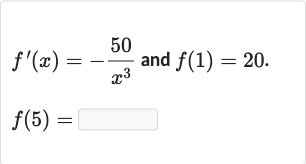AI tutor
Full solution
Q. and .
- Derivative Calculation: We have the derivative . To find , we need to integrate from to .
- Antiderivative Calculation: The antiderivative of is , where is the constant of integration.
- Constant of Integration: We know , so plug in to find : .
- Finding : Simplify to find : , so , .
- Simplification: Now we have . Plug in to find : .
- Final Result: Simplify the expression: , , .
- Final Result: Simplify the expression: , , . Final calculation: .
More problems from Operations with rational exponents
QuestionGet tutor help
QuestionGet tutor help
QuestionGet tutor help
QuestionGet tutor help
QuestionGet tutor help
QuestionGet tutor help
QuestionGet tutor help

